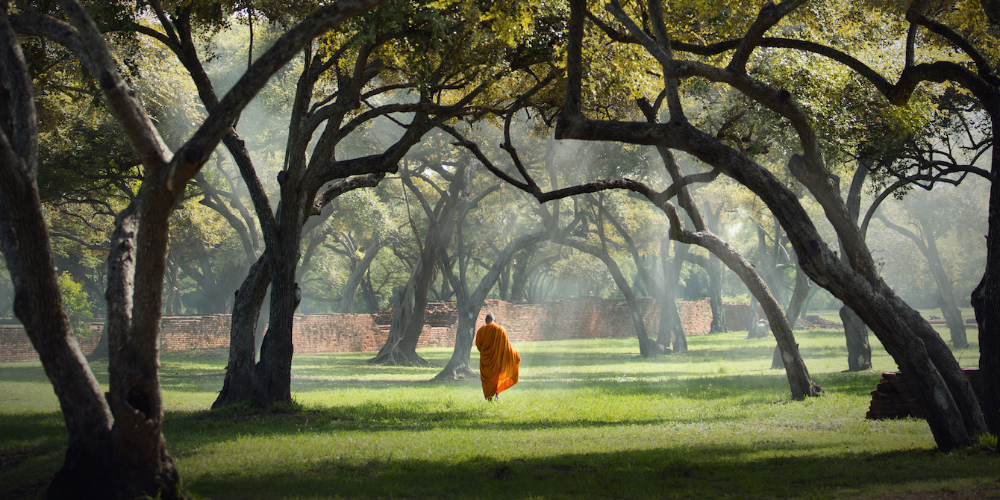Buddhism, a profound, ancient spiritual tradition, traces its roots back over 2 millennia to the teachings of Siddhartha Gautama, also known as the Buddha.
With its substantial impact on modern-day spirituality, understanding the origins of Buddhism is crucial to anyone seeking to live a spiritual or enlightened life.
In this article, we’ll explore where Buddhism originated, who founded it, and how it spread so successfully throughout the Asian continent.
Key takeaways:
- Buddhism originated between the 5th and 6th centuries BCE in Northern India on the border of modern-day Nepal.
- Siddhartha Gautama founded Buddhism after becoming enlightened under the Bodhi Tree and realizing the Four Noble Truths, which center around the origins and cessation of human suffering.
- With the help of Emperor Ashoka of the Mauryan Empire and the Silk Road, Buddhism spread throughout Central, East, and Southeast Asia, developing a strong presence in most Asian regions by the 12th century CE.
Buddhism is one of the oldest beliefs in the world, touching the hearts and minds of countless people for thousands of years…This story takes us back to the beginning of Buddhism, showing us where it came from and how it started to spread its message of love and enlightenment. – Dalai Lama, Spiritual leader of Tibetan Buddhism
Ready to explore Buddhist practices and philosophies? We have dozens of guided meditations, tracks, courses, and playlists on Buddhist meditation to get you started.
Where did Buddhism originate?
Buddhism, founded by Siddhartha Gautama (or Buddha), is a non-theistic religion and philosophy centered around a way of life that tries to overcome human suffering. The religion’s core teachings include the Four Noble Truths and the Eightfold Path, which emphasize:
- compassion
- detachment
- enlightenment
Gautama lived between the 4th and 6th centuries BCE in Northern India on the border of modern-day Nepal, where he moved from a life of wealth to extreme asceticism before receiving enlightenment under the Bodhi tree — after which he became known as Buddha or “the enlightened one.”
At the time, Indian society was steeped in rigid hierarchies and ritual sacrifices. And Buddhism introduced a new approach to spiritual liberation, one that was accessible to all regardless of societal rank. This pushed directly against India’s caste system and was a breath of fresh air in the intellectual and spiritual quests of the era.
Who was the founder of Buddhism, and what was his life story?
The story of Buddhism begins with a young prince named Siddhartha Gautama, born into luxury and royal comfort in Lumbini (present-day Nepal) around the 6th century BCE. One day, he went beyond his palace walls and saw people suffering from sickness, growing old, and facing death. Despite his privileged upbringing, Siddhartha found himself haunted by the realities of suffering and the inevitable truths of aging, sickness, and death.

How Siddhartha Gautama became the Buddha
Siddhartha’s observations sparked a deep yearning to understand the nature of suffering and find a way to overcome it. He studied with the prominent meditation teachers of the time and mastered all their techniques, yet he felt unsatisfied. Siddhartha even went as far as to adopt an ascetic lifestyle, mistakenly believing that the way to freedom was to completely deny bodily needs and any pleasure. He practiced the extremes of austerity and self-mortification in the forests of northern India for 6 years.
Towards the end of this period, he almost died from emaciation and exhaustion before realizing his efforts were futile. After some reflection, he decided to accept nourishment, care for his body, and change how he sought enlightenment—now known as the Middle Way.
According to accounts, on the full moon night in May, just before his 35th birthday, Siddhartha sat comfortably under a Bodhi tree. He began practicing mindfulness of breath and entered the same state of concentration and serenity he once experienced as a boy. This meditation led to more refined states and, eventually, a series of insights. By dawn, he realized the Four Noble Truths, including the end of dukkha (suffering), and became the Buddha, “The Awakened One,” or Shakyamuni.
The Four Noble Truths of Buddhism
- The truth of suffering
- The origin of suffering
- The truth that there is an end to suffering
- The way to the end of suffering
Want to learn more? Buddhism is full of rich wisdom that people of all backgrounds can benefit from. Dive into Buddha’s Four Noble Truths with this 4.9-star guided Noble Truths meditation by Tony Brady.
The Buddha’s life after enlightenment
Buddha’s journey as a teacher lasted for 4 decades, during which he established a strong and enduring foundation for Buddhism. He organized his community, set down rules for monastic life, and provided detailed teachings on the philosophical foundations of his path. His discourses, preserved by his followers, later became the suttas (or sutras in Sanskrit) — the Buddhist sacred texts that continue to guide practitioners today.
Even as he approached the end of his life, the Buddha continued to teach and serve as an example of enlightened living.
His last words to his followers were a simple but powerful message: to work diligently towards their own liberation, as no one else could do it for them.
He passed away at the age of 80, leaving behind a legacy that would flourish and adapt, touching the lives of millions across centuries and continents.
To dive deeper into the profound teachings of the Buddha and how they can impact your life, explore The Four Seals of Buddhism on Insight Timer.
Between the 6th and 4th centuries BCE, India was undergoing a major shift from an agrarian society to one focused on urban trade and manufacturing. This transition caused both intellectual and spiritual debates about what society was meant to believe in and value, which, until then, had been Hinduism.
Hinduism called for Sanatan Dharma, or Eternal Order, with life’s ultimate goal being to escape the cycle of rebirth through adherence to duty (dharma) and action (karma), guided by Hinduism’s ancient and revered texts, known as the Vedas.
In rejection of the more orthodox views of Hinduism, other philosophies began to spring up. The Charvaka philosophy, for instance, pushed for materialism that prioritized tangible experiences and pleasures of life over spiritual pursuits. Jainism, on the other hand, called for extreme asceticism, where strict non-violence and self-discipline practices constituted the path to liberation.
This diversity of thought in 6th- and 5th-century BCE India served as fertile ground for Siddhartha Gautama, the Buddha, to begin his quest for truth. This ultimately led to the founding of Buddhism, which he referred to as “The Middle Way” — a balance of the ideological extremes of the time.
To explore how the foundational principles of Buddhism can enhance your spiritual practice today, we suggest reading the Five Faculties of Buddhism, which covers the enduring wisdom of the Buddha’s teachings and how they can be applied to achieve balance and enlightenment in the modern world.

How did Buddhism develop and spread throughout Asia?
Buddhism became a major spiritual force that spread throughout Asia over the centuries following its founding. Below, we’ll dive more deeply into the roles of Emperor Ashoka, the Silk Road, and Buddhist missionaries, along with Buddhism’s evolution into different sects.
Who helped spread Buddhism?
A key figure in the spread of Buddhism was Emperor Ashoka of the Mauryan Empire, who, after witnessing the vast suffering caused by his military campaigns, converted to Buddhism and became its most influential patron. Ashoka’s profound transformation and dedication to Buddhism led him to establish monuments, build stupas (relic mounds), and inscribe edicts on pillars and rocks across his vast empire, promoting the Buddha’s teachings. He sent missionaries beyond India’s borders to regions like Sri Lanka, Southeast Asia, and even the Hellenistic kingdoms in the West.
The Silk Road also played a crucial part in the spread of Buddhism. Early Buddhist missionaries in the 1st and 2nd centuries CE used trade routes to set up Buddhist monasteries. As traders moved along these routes, they often interacted with Buddhist monks, offering them gifts in exchange for spiritual guidance. These interactions helped spread the Buddhist philosophy to previously untapped places like Burma (modern-day Myanmar), Thailand, Cambodia, Laos, Vietnam, Tibet, China, Korea, and Japan.
By the 12th century CE, Buddhism was firmly established in most of Asia.
How Buddhism branched into different sects
As Buddhism made its way around Asia in the early centuries of the common era, the religion adapted based on local religious and cultural contexts. This led to the development of three major sects with many smaller schools within each sect:
- Theravada (sometimes referred to as Hinayana)
- Mahayana
- Vajrayana (also known as Tibetan Buddhism).
While all three schools center around the idea of reaching nirvana, they vary in many ways, including the texts and teachings they follow and the paths available to enlightenment.
Theravada Buddhism, the oldest existing school, took root in Sri Lanka, Burma, and other parts of Southeast Asia. This sect emphasized the original teachings of the Buddha and the Pali Canon as its scriptural foundation.
Meanwhile, in Central and East Asia, Mahayana Buddhism emerged, introducing new sutras and the ideal of the Bodhisattva — a being who seeks enlightenment not only for themselves but for all sentient beings. When Mahayana reached China, for instance, it was met with Taoist and Confucian influence. The result was Chan (Zen) Buddhism, which emphasized meditation and the direct, personal experience of enlightenment. From the Chinese to the Japanese and Koreans, Mahayana Buddhism continued to adapt to the local traditions of East Asian culture.
Want to experience life more like a Buddhist monk? Western Monk Karma Yeshe Rabgye explains exactly how to practice self-restraint within Buddhist precepts for the greatest effect.
The importance of understanding the roots of Buddhism
Buddhist teachings underpin many modern-day spiritual and self-improvement practices, including mindfulness, meditation, and detachment. Inspired by the teachings of the Buddha more than 2,500 years ago, the religion remains just as relevant today, with a message that transcends time and geography. Accordingly, understanding how and where Buddhism originated can help you deepen your own spiritual practice and spread compassion and loving-kindness to others.
Cultivate a deeper understanding of Buddhism: We asked Buddhist monk Ajahn Achalo and Buddhist teacher Dr. Miles Neale what it means to be Buddhist. Read their inspiring and personal answers.
As part of the Insight Timer community, Mal Huxter freely offers guided meditations in order to reduce the suffering of others and increase their wellbeing and happiness. Start practicing meditation with these handpicked and popular guidances:
- Mindfulness Of Sound With Bells And Birds Mal Huxter 8:00
- Relaxing With The Breath Mal Huxter 12:08
- Resting In Awareness Mal Huxter 15:21
- Mindfulness Of Breath At Three Places Mal Huxter 16:41
- Loving Kindness Mal Huxter 17:24
Origin of Buddhism FAQs
Do Buddhists believe in God?
Unlike Western Christianity, Buddhism is non-theistic; it does not teach about the existence of a creator god. However, some forms of Buddhism incorporate local deities into their practices, but these are not seen as central to the path of enlightenment. Some Buddhist traditions involve devotional practices to bodhisattvas, who are beings that have reached enlightenment but choose to remain in the cycle of rebirth to help others.
Is Buddhism growing or declining?
Globally, Buddhism is maintaining a steady presence. In some parts of the world, it is experiencing growth due to its increasing popularity in the West and a resurgence in Asia. It is also experiencing growth in America due to an increasing interest in spirituality and meditation throughout American culture.
Is Buddhism older than Hinduism?
This is a complex question as Hinduism is a fusion of various Indian cultures and traditions with roots going back to prehistoric times, while Buddhism began around the 6th century BCE. Hindu beliefs may have been forming around the same time or even earlier.
Is Buddhism the same as Islam?
Buddhism and Islam are distinct religions with different origins, beliefs, and practices. Buddhism, founded by Siddhartha Gautama in the 6th century BCE in India, focuses on personal spiritual development and the attainment of a deep insight into the true nature of life. Islam, founded by Prophet Muhammad in the 7th century CE in Arabia, is a monotheistic faith centered on the worship of one God and following the teachings of the Quran.
What is Zen Buddhism?
Zen Buddhism is a school for Mahayana Buddhists that emphasizes the value of meditation and intuition rather than ritual worship or study of scriptures. It originated in China as Chan Buddhism and later spread to Japan, where it became known as Zen.
What is Mahayana Buddhism and what are its distinct features?
Mahayana Buddhism is one of the main branches of Buddhism and became popular in China, Japan, Korea, Tibet, and Vietnam. Mahayana Buddhists are characterized by a focus on the Bodhisattva path and the ideal of achieving enlightenment for the sake of all sentient beings.
Are Nirvana and Moksha the same?
Nirvana and Moksha are concepts found in Buddhism and Hinduism respectively, and while they are similar in that they both represent liberation from the cycle of rebirth, they are distinct concepts within their own religious frameworks.
What are Right Speech and Right Mindfulness in Buddhism?
Right Speech and Right Mindfulness are parts of the Noble Eightfold Path in Buddhism. Right Speech means speaking truthfully and kindly, avoiding lies, harmful words, and useless talk. It encourages creating harmony through our words. Right Mindfulness is being fully aware and present in the moment, understanding our thoughts, feelings, and actions without judgment. It helps us make better choices and understand the true nature of life.
References
Information on Buddha Childhood & Four Noble Signs. (n.d.). Www.nepal-Tibet-Buddhas.com. Retrieved March 15, 2024, from https://www.nepal-tibet-buddhas.com/about-buddha/buddha-childhood/
Mark, J. (2020, September 23). Siddhartha Gautama. World History Encyclopedia. https://www.worldhistory.org/Siddhartha_Gautama/
Mark, J. (2020, September 25). Buddhism. World History Encyclopedia. https://www.worldhistory.org/buddhism/







